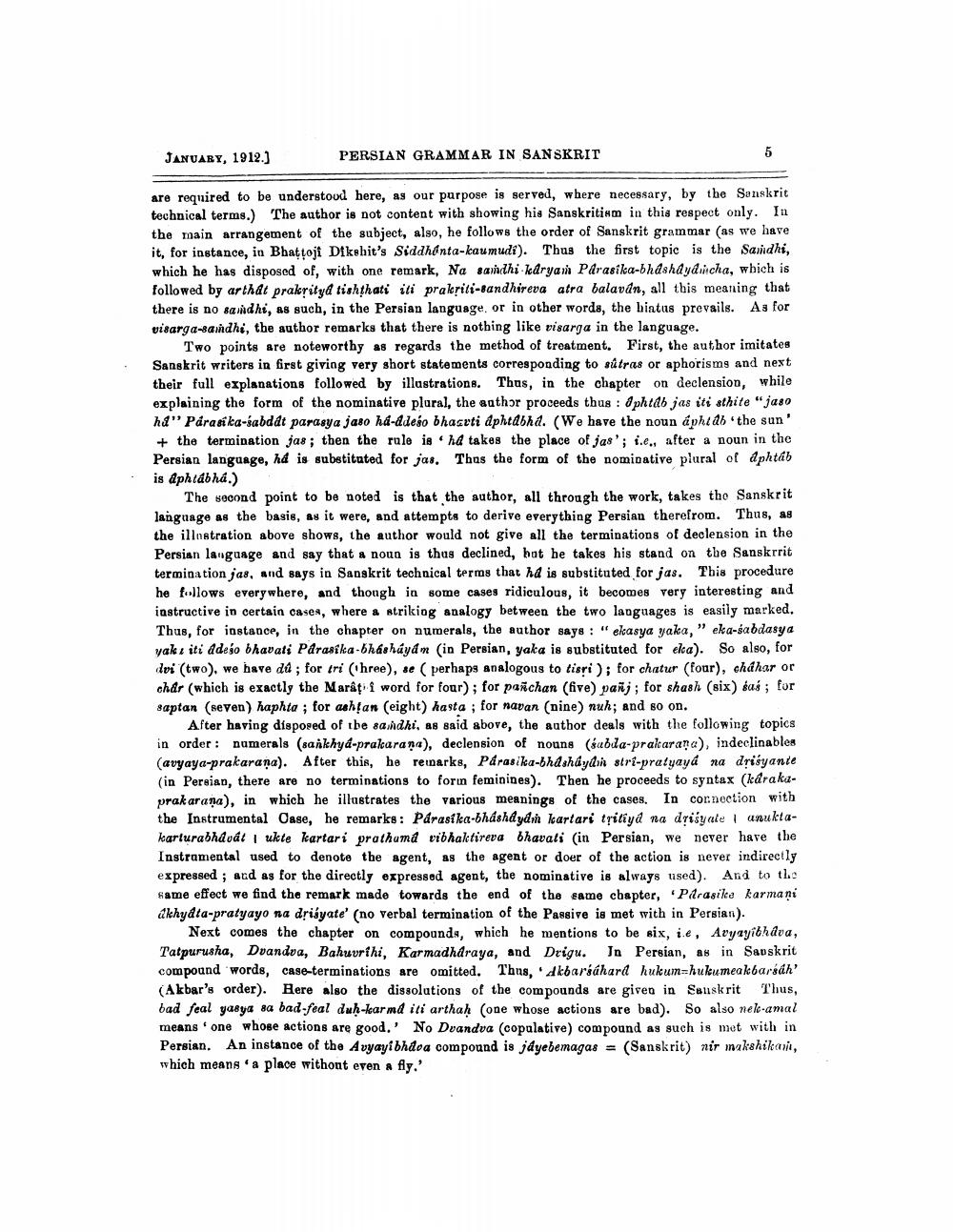Book Title: Indian Antiquary Vol 41 Author(s): Richard Carnac Temple, Devadatta Ramkrishna Bhandarkar Publisher: Swati Publications View full book textPage 9
________________ JANUARY, 1912.) PERSIAN GRAMMAR IN SANSKRIT are required to be understood here, as our purpose is served, where necessary, by the Sanskrit technical terms.) The author is not content with showing his Sanskritism in this respect only. In the main arrangement of the subject, also, he follows the order of Sanskrit grammar (as we have it, for instance, in Bhattoji Dikshit's Siddhanta-kaumudi). Thus the first topic is the Saindhi, which he has disposed of, with one remark, Na sandhi karyan Parasika-bhashaydincha, which is followed by arthat prakrityd tishthati iti prakriti-Bandhireva atra balaván, all this meaning that there is no sandhi, as such, in the Persian language, or in other words, the hiatus prevails. As for visarga-saindhi, the author remarks that there is nothing like visarga in the language. Two points are noteworthy as regards the method of treatment. First, the author imitates Sanskrit writers in first giving very short statements corresponding to sútras or aphorisms and next their full explanations followed by illustrations. Thus, in the chapter on declension, while explaining the form of the nominative plural, the anthor proceeds thus : Iphtdb jas iti sthite "jaso ha" Párasika-sabdát parasya jaso ha-ddeso bhacrti dphtabhd. (We have the noun áphtdb.the sun' + the termination jas; then the rule isha takes the place of jas'; i.e., after a noun in the Persian language, há is substituted for jas. Thas the form of the nominative plural of dphtáb is aphidbha.) The second point to be noted is that the author, all through the work, takes tho Sanskrit language as the basis, as it were, and attempts to derive everything Persian therefrom. Thus, as the illustration above shows, the author would not give all the terminations of declension in the Persian language and say that a noun is thus declined, hat he takes his stand on the Sanskrit termination jas, and says in Sanskrit technical terms that he is substituted for jas. This procedure he follows everywhere, and though in some cases ridiculous, it becomes very interesting and instructive in certain cases, where a striking analogy between the two languages is easily marked. Thus, for instance, in the chapter on numerals, the author says: "ekasya yaka," eka-sabdasya yakı iti adego bhavati Parasika-bhashayam (in Persian, yaka is substituted for elca). So also, for dvi (two), we have dú; for tri (three), se perhaps analogous to tisri); for chatur (four), chdhar or char (which is exactly the Marât i word for four); for pañchan (five) paij; for shash (six) sas; for saptan (seven) haphta ; for ashtan (eight) hasta ; for navan (nine) nuh; and so on. After having disposed of the sandhi, as said above, the author deals with the following topics in order: numerals (sankhya-prakarana), declension of nouns (subda-prakarana), indeclinables (avyaya-prakarana). After this, he retparks, Parasika-bhasháydın stri-pratyayá na drisyante (in Persian, there are no terminations to forn feminines). Then he proceeds to syntax (kárakıprakarana), in which he illustrates the various meanings of the cases. In connection with the Instrumental Case, he remarks: Parasika-bhashdydı kartari tritiya na drisy ale i unuktakarturabhdoát lukte kartari prathamd vibhaktireva bhavali in Persian, we never have the Instrumental used to denote the agent, as the agent or doer of the action is never indirectly expressed ; and as for the directly expressed agent, the nominative is always used). And to the same effect we find the remark made towards the end of the same chapter, Pdrasilea karmani dkhydta-pratyayo na driyate' (no verbal termination of the Passive is met with in Persian). Next comes the chapter on compounds, which he mentions to be six, i.e, Avyayibh dva, Tatpurusha, Dvandva, Bahuvrihi, Karmadharaya, and Drigu. In Persian, as in Sanskrit compound words, case-terminations are omitted. Thns, Akbarichard hukum-hukumeakbar dh' (Akbar's order). Here also the dissolutions of the compounds are given in Sanskrit Thus, bad feal yasya sa bad-feal duh-karmd iti arthah (one whose actions are bad). So also nele-amal means 'one whoBe actions are good.' No Dvandva (copulative) compound as such is met with in Persian. An instance of the Avyayi bhdoa compound is jdyebemagas = (Sanskrit) nir makshikaril, which means a place without even a fly.'Page Navigation
1 ... 7 8 9 10 11 12 13 14 15 16 17 18 19 20 21 22 23 24 25 26 27 28 29 30 31 32 33 34 35 36 37 38 39 40 41 42 43 44 45 46 47 48 49 50 51 52 53 54 55 56 57 58 59 60 61 62 63 64 65 66 67 68 69 70 71 72 73 74 75 76 77 78 79 80 81 82 83 84 85 86 87 88 89 90 91 92 ... 320
